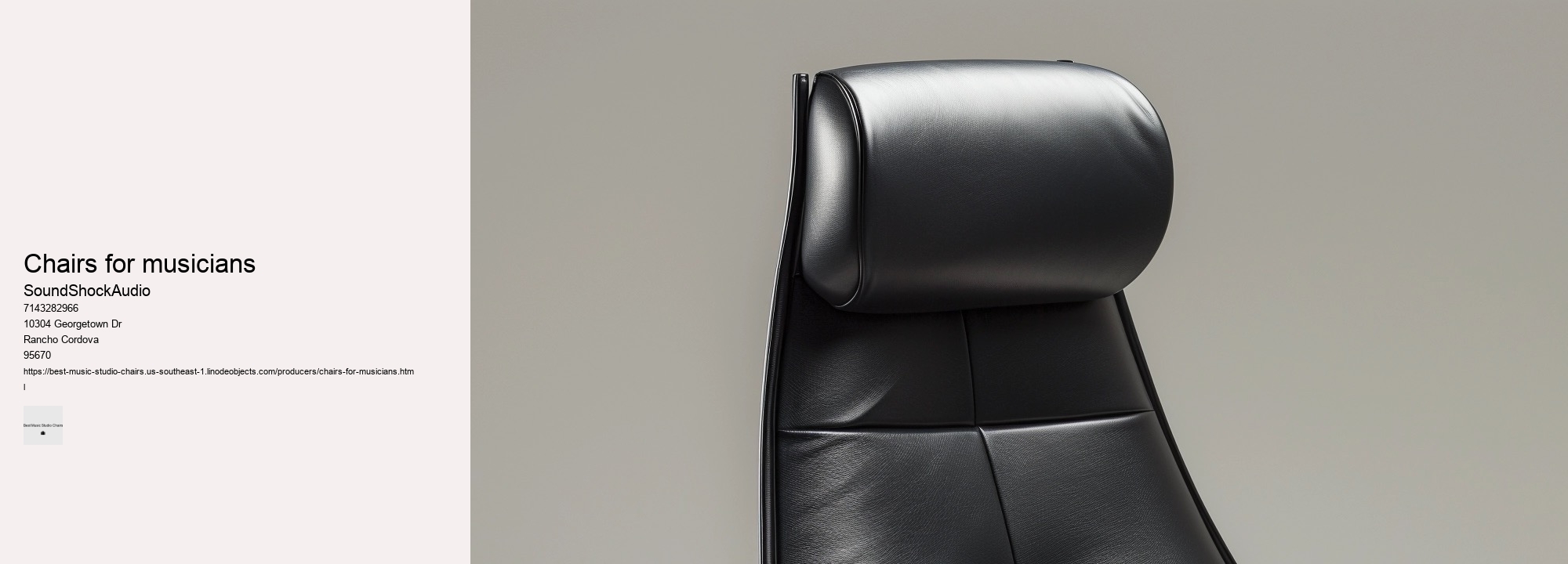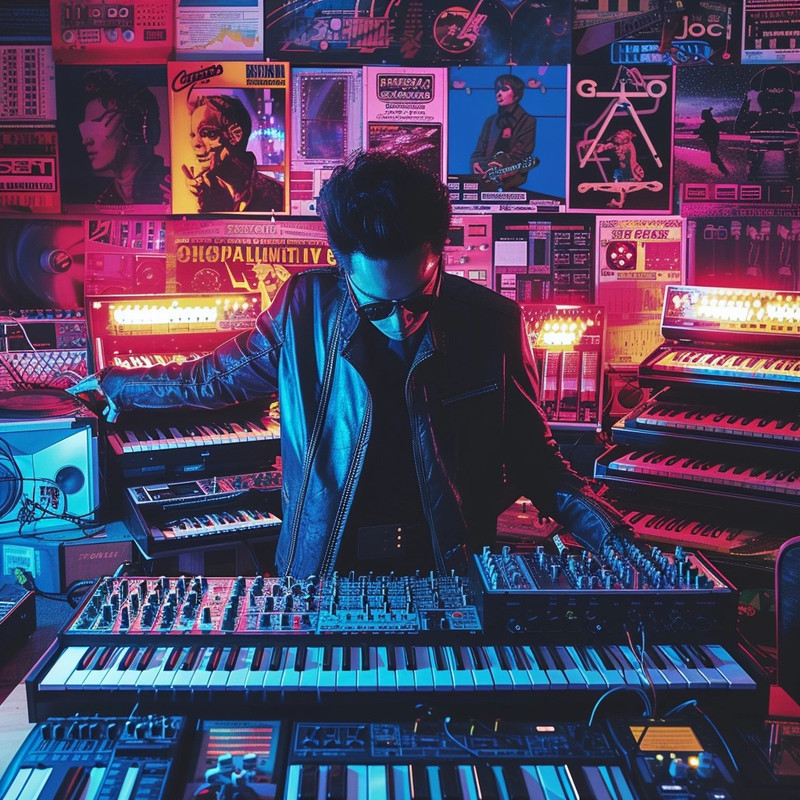

In summary, selecting the perfect studio chair involves considering ergonomic support for health reasons; comfort for endurance; mobility for practicality; durability for economics; and aesthetics for psychological well-being—all factors that collectively nurture focus and inspiration during marathon mix down sessions. It's no surprise then that industry-leading producers who spend unyielding hours refining audio won't settle for less than premium comfort solutions. Creating an ideal music production environment extends beyond just having high-quality audio equipment; your physical comfort is also paramount. While they don't directly impact comfort or ergonomics, pleasing designs can inspire creativity—a subtle yet significant benefit for those working in creative fields. Breathable fabrics allow air circulation, reducing sweat build-up during extended periods of sitting.
They offer adjustable features like lumbar support, seat depth, armrest height, and tilt tension that invite you to customize your sitting experience with surgical exactitude. Owners can rejoice not only in physical ease but also environmental peace of mind. Its innovative features—temperature regulation, durability, hypoallergenic properties—and potential for enhancement with additional technologies make it a standout material that has truly transformed our expectations for comfortable seating solutions in creative spaces. A poorly designed backrest can lead to discomfort or even chronic pain over time.
Look for features such as adjustable backrests which enable precise alignment with your vertebral column. By selecting chairs that offer optimal support and adjustability, professionals can enhance their practice sessions and performances, ensuring they stay attuned both physically and mentally. While such chairs command a premium price tag, they represent an investment in one's health and efficiency. The right chair can be pivotal in sustaining healthful practices while fostering an environment conducive to creative success—an investment worth making for any dedicated music professional looking to deliver their best work comfortably session after session.
Its sturdy construction guarantees that every component from casters to armrests remains functional through countless recording sessions. Ergonomic chairs encourage a sitting posture that aligns your back, neck, and hips, reducing strain on these areas. Made with recyclable materials and designed for longevity, the Håg Capisco Puls respects both user well-being and ecological sustainability. These less probable options highlight by contrast what makes certain choices superior when selecting an optimal studio chair.
Creating a harmonious and functional small home studio demands meticulous attention to detail, particularly when it comes to selecting the right chair. This increases efficiency as you reach for different pieces of equipment or instruments during your session. Selecting the perfect studio chair is akin to composing a harmonious melody; it requires attention to both comfort and style, ensuring that each element resonates with your personal preferences and workspace needs.
A chair too rigid might impede movement; one too soft could lead to poor posture and subsequent discomfort or even injury over time. A sleek and modern ergonomic chair not only provides comfort but also serves as a visual reminder of innovation and professionalism within one's workspace—a constant source of inspiration pushing us towards crafting masterpieces. But rest assured knowing that investing time researching chairs pays dividends far greater than many initially perceive possible when embarking upon their melodic journey through endless nights bathed in dimly lit studios searching for that perfect beat—that elusive hook—that defining moment where everything clicks into place creating timeless pieces capable of touching souls across generations ad infinitum.
Thus concludes our capricious cataloging of esteemed studio chairs—champions chosen not through frivolous fancy but rigorous rendezvous between artist and instrument; where each note played is nurtured by unseen sentries made tangible only through absence when melody falters upon their departure—a testament to their silent symphony conducted below radar yet resonating beyond audible spectrums. Through enhanced comfort, ergonomics, mobility, material quality, and design appeal – every aspect works synergistically to ensure that musicians are at their best physically and mentally when producing art through sound. Here's an unconventional guide to finding a chair that hits all the right notes.
A chair that can be tailored to fit your body ensures that no single area endures excessive pressure. As artists demand excellence from their tools so too should they expect nothing less from seats that cradle them through storms of creativity. Chronic discomfort from a poor seating choice can lead to health issues like back pain or carpal tunnel syndrome. While aesthetic preferences evolve rapidly within creative fields, investing in timeless craftsmanship ensures that a top studio chair remains both functional and stylish across eras. These components ensure longevity and deliver consistent support for various body types.
Finally, while budget considerations may play second fiddle in this selection concerto, they cannot be ignored completely. Ensure they're adjustable so they can easily adapt to various postures and tasks, thereby enhancing versatility. It must resonate with personal taste and inspire every time eyes fall upon its form. Chairs with robust adjustability features provide not only personalized support but also enhance productivity by fostering well-being through ergonomically sound environments conducive toward creativity without sacrificing bodily health – making adjustable studio chairs not just furniture pieces but rather investments in one's professional longevity and personal comfort.
The task involves discussing a revolutionary studio chair that has transformed the comfort of music production, but with a twist in the language usage that might lead to a somewhat nonsensical or abstract composition. For those who master soundscapes daily, investing in a high-quality chair isn't mere luxury—it's an essential component of their craft. Through ergonomic furniture options combined with personal vigilance regarding posture and movement habits, we stand a much better chance of safeguarding our health against the silent yet significant threats posed by inadequate seating arrangements. When seated upon such an exalted perch, distractions fade away like distant echoes; all that remains is you intertwined with your craft—unified in purposeful creation.
Yet sometimes, game-changing improvements are surprisingly simple. Musicians should have access to comfortable seating adjusted specifically for their posture and instrument positioning, reducing physical strain over prolonged periods. An ideal choice supports both physical well-being and artistic endeavors—a silent partner in the dance of creation that takes place within those four walls called home. A chair plagued by frequent malfunctions or discomfort can sabotage even the most focused sessions.


The adjustable armrests cater to various instrument playing heights, providing essential support for shoulders and arms. This fluid movement can preserve energy and maintain creative focus. This visual harmony creates an ambiance conducive to uninhibited expression.
The quest for the perfect studio chair resembles searching for a needle in a haystack. gaming chair for A critical yet often overlooked element of this creative space is the chair you sit on during those long hours of production.
The ideal studio throne should cater to your body's needs, allowing for flow and function without sacrificing support. These tools enable workers to alternate between sitting and standing positions seamlessly throughout the day without interrupting workflow efficiency.
Features such as adjustable height, lumbar support, and armrests that can be tailored to suit your physical dimensions will minimize discomfort and distraction. Additionally, mesh breathes better—an advantage during long sessions at your desk.
Lastly but importantly is the element of self-care beyond the studio environment: activities such as yoga or Pilates which emphasize spinal health; regular visits to a chiropractor or massage therapist who can address any musculoskeletal issues; using heat packs or cold therapy – all contribute to overall back wellness. It might seem trivial at first glance, but the right studio chair can significantly elevate your music creation sessions. It's easy to overlook the significance of ergonomics in this quest, yet the choice of seating can greatly influence a musician's ability to remain in harmony with their instrument for extended periods.
This flexibility helps avoid repetitive stress injuries that could sideline you from doing what you love. Choose a chair with adjustable features—think lumbar support that defies gravity or armrests that refuse conformity—allowing you to orchestrate your ideal sitting posture.
But what about aesthetics? The silhouette of a studio chair also communicates much about its character: whether it's minimalist lines that echo modernist sensibilities or more ornate structures that nod to classical influences.
Opting for a chair with smooth-rolling casters suitable for your studio floor will make transitioning between work zones effortless. Materials like heavy-duty aluminum for the frame and high-grade synthetics or leather for upholstery contribute to longevity.

An optimal chair allows you to sit firmly with your feet planted on the ground while leaving a small gap between your knees and the edge of the seat. Another key element contributing to its comfort is its environmentally conscious construction. It's less about grandeur or aesthetics and more about ergonomics and personal well-being. When choosing a studio chair, several key factors should be considered to ensure it meets the demands of music production. Ergonomic design is at the heart of these specialized chairs. furniture
A top-rated studio chair isn't just furniture; it’s an indispensable companion on your creative journey—a steadfast ally ensuring every note is hit with precision because you stayed comfy through those intense mixing marathons. Leather chairs can symbolize opera’s grandiosity but might not breathe well during extended sessions. Ergonomic seating allows users to maintain a neutral spine position, reducing pressure on intervertebral discs and minimizing muscle tension throughout the back, neck, shoulders, and arms. Moreover, time equals money in any production environment - be it music, video editing, or graphic design - and efficiency is king.
A poorly designed chair can lead to discomfort, fatigue, and even chronic pain over time. The aesthetics of these chairs are not merely a byproduct of function but an intentional dialogue with the very essence of style. Adjustable in every sense, from armrest height to lumbar support tension, this chair adapts to you rather than demanding your adaptation to it. Being able to adjust these elements ensures that your body maintains an optimal posture throughout your session.
The first enigmatic contender is a chair draped in moonlight velvet—a peculiar choice for studios drenched in shadow and sound waves. This pursuit of auditory bliss can span hours, if not days - a testament to the dedication required to birth a musical masterpiece. Certainly! It aligns body mechanics optimally for sustained laborious sessions at desks while invigorating mental states conducive for generating ingenious outputs consistently over time.
While not as advanced as some higher-end models, its simple design coupled with decent build quality makes it suitable for less intense studio environments. It will result in a composition that may not always make perfect sense or maintain logical coherence, as it deliberately introduces random and potentially unrelated elements into the text. Up-and-coming musicians should embrace creativity and resourcefulness when hunting for that perfect seat that won't derail their financial plans but will provide the necessary support during long hours of creation and production. Choosing one of these chairs means investing in yourself and your craft. Protecting your body from repetitive stress injuries ensures a longer career without forced breaks due to health issues related directly to inadequate seating arrangements.
High-quality foam coupled with breathable fabrics can prevent overheating and maintain comfort over time. Investing in a high-quality model made from robust materials will save money in the long run as it won't require frequent replacements due to wear and tear. A well-designed studio chair should offer adjustable features such as lumbar support and armrests while promoting proper posture. In the realm of creative endeavors, comfort often becomes the unsung hero of productivity.
Tailoring this aspect of a chair helps cradle the natural curve of your spine, offering targeted relief and preventing slouching. Secondly, comfort cannot be overstated. Remember that beating studio fatigue isn't just about having the right equipment—it's about fostering habits that promote well-being both physically and mentally. Whichever camp you fall into, remember that breathability remains essential; materials like mesh allow air circulation which prevents overheating during marathon sessions.
They offer tangible benefits for health and artistic expression even if our discussion includes unexpected detours like "elephants elegantly embroider euphonious echoes," which charmingly illustrates how randomness can sometimes weave poetry into prose but may leave readers bewildered regarding practical advice on choosing seating solutions for music-making endeavors. It aims to support your body so well that you barely notice it's there. The tilt tension control allows users to recline comfortably while maintaining control over their seating angle – an important factor when trying to find an optimal balance between relaxation and concentration during various tasks throughout the day. Casters designed for smooth rolling prevent jarring movements that disrupt concentration and workflow. Warranty
Choosing the right chair for your home office depends on several factors including ergonomics, budget, and personal style. Ergonomic chairs that offer adjustable features such as lumbar support, armrests, and seat height are ideal for long hours of work to prevent strain and discomfort. It's also important to consider the chair's material and durability to ensure it fits your work environment and lasts long. Brands like Herman Miller, Steelcase, and Secretlab are often recommended for their quality and range of options catering to different needs and preferences.
A chair that you can sit in for 8 hours should be ergonomically designed to support your posture, reduce back strain, and enhance comfort. It typically features adjustable settings for height, armrests, lumbar support, and tilt to accommodate various body shapes and sitting preferences. Examples include high-quality office chairs from brands like Herman Miller, Steelcase, or Humanscale, which are specifically engineered for long periods of sitting while minimizing discomfort and promoting productivity.
Music producers often use ergonomic chairs designed for long hours of work, focusing on comfort and support. Popular choices include the Herman Miller Aeron and the Steelcase Leap, which offer adjustable features to fit a wide range of body types and preferences. These chairs help in maintaining good posture and reducing fatigue during extended studio sessions.
A reasonable amount to spend on an office chair largely depends on your budget, ergonomic needs, and how much time you spend sitting in it. For a chair that offers basic comfort and support, spending between $100 to $300 can be adequate. However, for those who prioritize ergonomics and spend extensive hours at their desk, investing $500 or more on a high-quality office chair that provides adjustable features and superior support might be worthwhile.
Ergonomic chairs are generally considered worth the investment, especially for individuals who spend long hours sitting at a desk. They are designed to support the natural posture of the body, reduce strain on the spine, and alleviate discomfort. Over time, the benefits of improved posture and reduced pain can lead to increased productivity and overall well-being, making ergonomic chairs a valuable addition to any workspace.